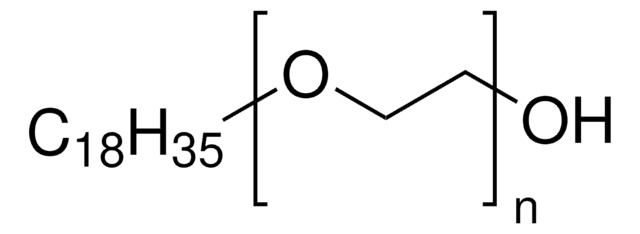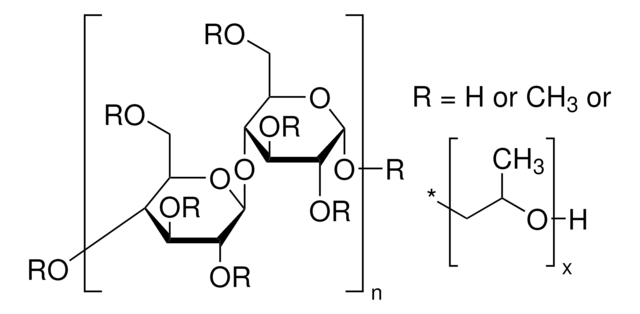STS0213
ECO BRIJ® O10
Sinônimo(s):
Brij® O10, Brij 97, C18-1E10, Polyoxyethylene (10) oleyl ether
About This Item
Produtos recomendados
descrição
non-ionic
Nível de qualidade
Formulário
semisolid
peso molecular
~709 g/mol
características do produto alternativo mais ecológico
Use of Renewable Feedstocks
Design for Degradation
Learn more about the Principles of Green Chemistry.
sustainability
Greener Alternative Product
Impurezas
≤3.0% water
pf
25 °F
número de acidez
≤1.0 mg KOH/g
índice de hidroxila
75‑95 mg KOH/g
solubilidade
water: 100 mg/mL, clear, colorless to faintly yellow
densidade
1 g/mL at 25 °C (lit.)
HLB
12.4
categoria alternativa mais ecológica
, Aligned
cadeia de caracteres SMILES
O(CCO)CCCCCCCC\C=C/CCCCCCCC
InChI
1S/C20H40O2/c1-2-3-4-5-6-7-8-9-10-11-12-13-14-15-16-17-19-22-20-18-21/h9-10,21H,2-8,11-20H2,1H3/b10-9-
chave InChI
KWVPFECTOKLOBL-KTKRTIGZSA-N
Procurando produtos similares? Visita Guia de comparação de produtos
Descrição geral
Aplicação
Características e benefícios
- 100 % Renewable
- 100 % Bio-based
- Certified to the USDA BioPreferred Program
- Lower carbon footprint than petrochemical-based versions
- High-purity chemical suitable for a wide variety of research applications
propriedades físicas
Outras notas
Informações legais
Palavra indicadora
Warning
Frases de perigo
Declarações de precaução
Classificações de perigo
Aquatic Chronic 2 - Skin Irrit. 2
Código de classe de armazenamento
11 - Combustible Solids
Classe de risco de água (WGK)
WGK 1
Ponto de fulgor (°F)
>464.0 °F - Equilibrium method
Ponto de fulgor (°C)
> 240 °C - Equilibrium method
Escolha uma das versões mais recentes:
Certificados de análise (COA)
It looks like we've run into a problem, but you can still download Certificates of Analysis from our Documentos section.
Se precisar de ajuda, entre em contato Atendimento ao cliente
Já possui este produto?
Encontre a documentação dos produtos que você adquiriu recentemente na biblioteca de documentos.
Nossa equipe de cientistas tem experiência em todas as áreas de pesquisa, incluindo Life Sciences, ciência de materiais, síntese química, cromatografia, química analítica e muitas outras.
Entre em contato com a assistência técnica






